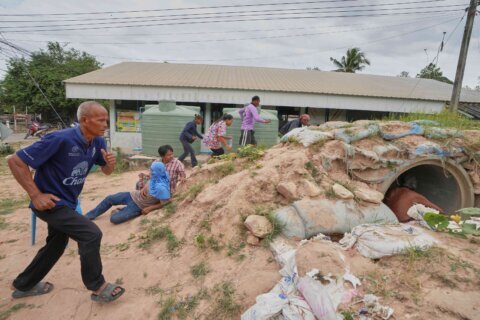BETHESDA, Md. – With $68 million in federal grants from the Department of Defense, the Montgomery County Department of Transportation unveiled a plan to improve pedestrian access among the National Institutes of Health, Metro and the Walter Reed National Military Medical Center.
Under the plan, an underpass for pedestrians and bicyclists would connect people on the street to a tunnel that would run under Md. 355 (Rockville Pike/Wisconsin Avenue) to the other side.
The plan also calls for deep elevators on the east side of Md. 355 to allow people leaving the military base to connect directly with the Medical Center Metro station platforms.
“In this case, the traffic is so heavy on 355 that people are eager to cross the street and many times even when the light isn’t in their favor. It’s just unsafe condition for pedestrians,” said Holger Serrano, deputy chief of engineering services at the Montgomery County Department of Transportation.
“So by having the elevator and the underpass, it gives pedestrians another option to cross 355. I think people will use it because it’ll save them time.”
Montgomery County Base Realignment and Closure Coordinator Phil Alperson agrees.
“You can see pedestrians trying to rush across the street when the light is yellow or maybe after that. You can see motorists creeping across the intersection when the light is yellow or maybe after that. It’s very dangerous,” he said.
In 2012, Metro said there were 6,010 passenger boardings per weekday at the Medical Center station, meaning more than 10,000 total trips to or from the station, assuming commuters made round-trips.
The Maryland State Highway Administration estimates about 60,000 vehicle trips along Md. 355 between the Capital Beltway and the Medical Center region.
“I think it’ll absolutely be much safer for pedestrians after the deep elevator and pedestrian underpass are built,” said Alperson.
But Ben Ross, who advocates for the Action Committee for Transit on pedestrian issues, does not agree it’ll make the situation better.
“I think the deep elevators are tremendous. But the tunnel is essentially just a waste of money, which no one will use. It’ll just be faster to cross on the street, so why are we spending tens of millions on the underpass? Metro did a study and found it would take longer to cross under 355,” said Ross.
Serrano and Alperson disagree with Ross. Both believe the tunnel will make crossing Md. 355 quicker and become a popular option for pedestrians.
Ross advocates policies that intentionally slow down traffic with calming measures to make sure drivers take into account pedestrians that share the road.
The debate presents a delicate balancing act for transportation officials. Drivers complain about traffic and want quicker commutes. Pedestrians want drivers to slow down to make it safe to cross, which makes for longer commutes.
Richard Hoye believes this move is a thinly-veiled attempt to cater to drivers.
“While the deep elevators are a good idea, the tunnel is not. It’s an idea that serves car traffic at the expense of pedestrians because the intent of studies in this area all along is about traffic flow and how to keep vehicles moving faster and for longer,” said Hoye.
Other participants in a public meeting on Tuesday expressed concern about whether disabled veterans will be able to use the tunnel, since many of those going to the Medical Center are wounded warriors.
The Montgomery County Department of Transportation will issue a request for proposal this fall. Serrano says construction could begin in the fall of 2014 and be completed in the fall of 2017.
This story has been updated.
Follow @WTOPTraffic and @WTOP on Twitter.







